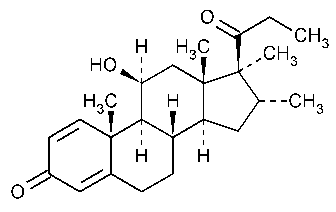Rimexolone
Androsta-1,4-diene-3-one,11-hydroxy-16,17-dimethyl-17-(1-oxopropyl)-,(11b,16a,17b)-.
11b-Hydroxy-16a,17a-dimethyl-17-propionylanddrosta-1,4-diene-3-one [49697-38-3].
»Rimexolone contains not less than 97.0percent and not more than 102.0percent of C24H34O3,calculated on the dried basis.
Packaging and storage—
Preserve in well-closed containers.
Identification—
A:
Infrared Absorption á197Kñ.
B:
Prepare a test solution in chloroform containing 10mg per mL.Separately apply 5µLof this solution and 5µLof a Standard solution of USP Rimexolone RSin chloroform containing 10mg per mLto a thin-layer chromatographic plate (see Chromatography á621ñ)coated with a 0.25-mm layer of chromatographic silica gel mixture.Allow the spots to dry,and develop the chromatogram in a solvent system consisting of a mixture of chloroform and methanol (19:1)until the solvent front has moved about three-fourths of the length of the plate.Remove the plate from the developing chamber,mark the solvent front,and allow the solvent to evaporate.Observe the plate under short-wavelength UVlight:the RFvalue of the principal spot obtained from the test solution corresponds to that of the principal spot obtained from the Standard solution.
Specific rotation á781Sñ:
between +47 and +54
and +54 .
.
Test solution:
20mg per mL,in chloroform.
Loss on drying á731ñ—
Dry it in vacuum at 105 for 3hours:it loses not more than 1.0%of its weight.
for 3hours:it loses not more than 1.0%of its weight.
Residue on ignition á281ñ:
not more than 0.1%.
Heavy metals,Method IIá231ñ:
0.002%.
Chromatographic purity—
Mobile phase and Chromatographic system—
Proceed as directed in the Assay.
Procedure—
Inject a volume (about 20µL)of the Test solutioninto the chromatograph,record the chromatogram,and measure the peak responses.Calculate the percentage of each impurity in the portion of Rimexolone taken by the formula:
100(ri/rs),
in which riis the peak response for each impurity,and rsis the sum of the responses of all of the peaks:not more than 1.0%of any individual impurity is found,and the sum of all impurities is not more than 2.0%.
Organic volatile impurities,Method Vá467ñ:
meets the requirements.
Assay—
Mobile phase—
Prepare a filtered and degassed mixture of acetonitrile and water (6:4).Make adjustments if necessary (see System Suitabilityunder Chromatography á621ñ).
Standard preparation—
Dissolve an accurately weighed quantity of USP Rimexolone RSin methanol,and dilute quantitatively,and stepwise if necessary,with Mobile phaseto obtain a solution having a known concentration of about 0.2mg per mL.
Assay preparation—
Transfer about 25mg of Rimexolone,accurately weighed,to a 25-mLvolumetric flask,dissolve in and dilute with methanol to volume.Transfer 5.0mLof this solution to a 25mL-volumetric flask,dilute with Mobile phaseto volume,and mix.
Chromatographic system
(see Chromatography á621ñ)—The liquid chromatograph is equipped with a 242-nm detector and a 4.6-mm ×25-cm column that contains packing L1.The flow rate is about 1mLper minute.Chromatograph the Standard preparation,and record the peak responses as directed for Procedure:the capacity factor,k¢,is not less than 1.5,the column efficiency is not less than 3000theoretical plates,the tailing factor is not more than 2.0,and the relative standard deviation for replicate injections is not more than 2.0%.
Procedure—
Separately inject equal volumes (about 20µL)of the Standard preparationand the Assay preparationinto the chromatograph,record the chromatograms,and measure the responses for the major peaks.Calculate the quantity,in mg,of C24H34O3in the portion of Rimexolone taken by the formula:
125C(rU/rS),
in which Cis the concentration,in mg per mL,of USP Rimexolone RSin the Standard preparation,and rUand rSare the peak responses obtained from the Assay preparationand the Standard preparation,respectively.
Auxiliary Information—
Staff Liaison:Daniel K.Bempong,Ph.D.,Scientist
Expert Committee:(PA2)Pharmaceutical Analysis 2
USP28–NF23Page 1734
Phone Number:1-301-816-8143
